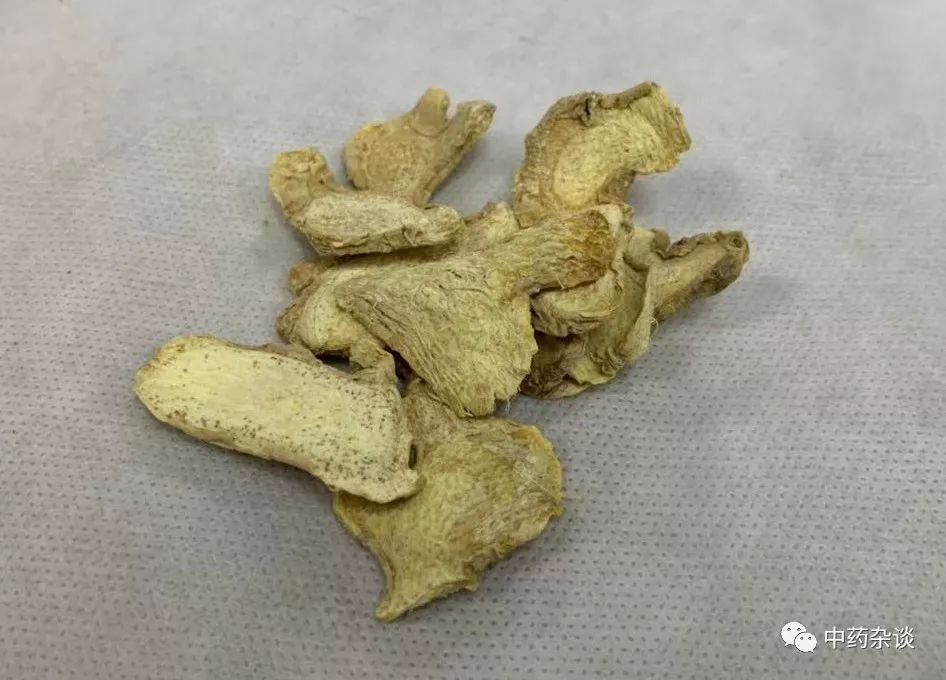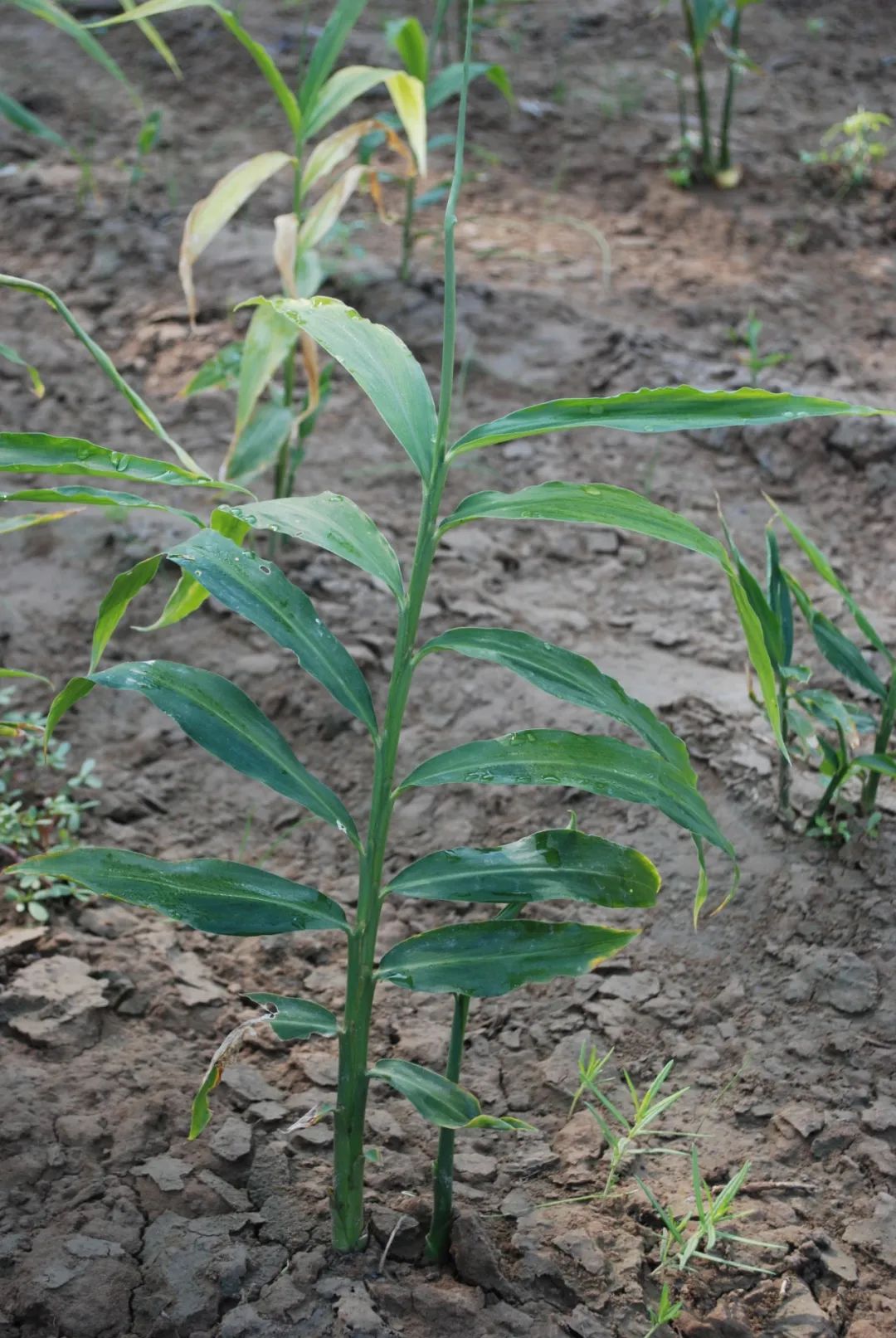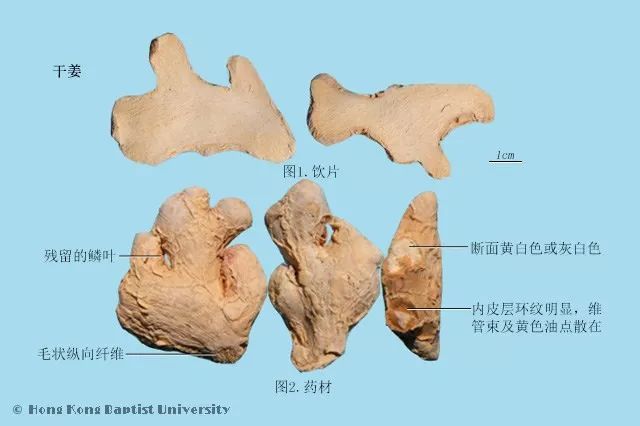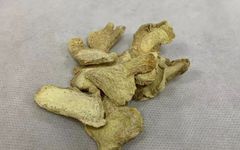Dried Ginger (Pao Jiang) from the Shen Nong Ben Cao Jing
Zingiberis Rhizoma
Source and Name Explanation
The dried rhizome of the ginger plant (Zingiber officinale)
Effects and Memory Aids
Warming the middle, restoring yang, warming the lungs and transforming phlegm
Characteristics
Spicy, hot, and dispersing, it enters the spleen and stomach meridians, dispelling cold evil from the spleen and stomach while assisting the yang qi of the spleen and stomach, making it a key herb for warming the middle and dispersing cold. It is suitable for both excess and deficiency cold syndromes. It enters the heart meridian, can restore yang and open the vessels, often combined with Fu Zi (Aconite) to treat impending yang collapse. It enters the lung meridian, can warm the lungs and transform phlegm, commonly used for cough and wheezing due to cold phlegm.
Indications
-
Abdominal pain, vomiting, and diarrhea caused by cold or deficiency cold in the spleen and stomach
-
Imminent yang collapse
-
Cough and wheezing due to cold phlegm
Images

 Source: Hong Kong Baptist University Traditional Chinese Medicine Material Image DatabaseIdentification CharacteristicsDried Gingeris flat and block-like, with finger-like branches, 3-7 cm long and 1-2 cm thick, with a surface that is grayish-yellow or light gray-brown, rough, with longitudinal wrinkles and distinct nodes. The branch tips often have remnants of scale leaves, and the branch tops have stem scars or buds. The texture is solid, with a cross-section that is yellowish-white or grayish-white, powdery or granular, with distinct annular patterns in the inner skin layer, vascular bundles, and scattered yellow oil spots. It has a fragrant and unique aroma, with a spicy taste.Dried Ginger Slicesare irregular longitudinal or oblique slices, 1-6 cm long, 1-2 cm wide, and 0.2-0.4 cm thick, with an outer skin that is grayish-yellow or light brown, rough, with longitudinal wrinkles and distinct nodes. The cut surface is grayish-yellow or grayish-white, slightly powdery, with many longitudinal fibers, some appearing hairy. The texture is solid, with a fibrous cross-section, fragrant and unique, with a spicy taste.Processing Methods
Source: Hong Kong Baptist University Traditional Chinese Medicine Material Image DatabaseIdentification CharacteristicsDried Gingeris flat and block-like, with finger-like branches, 3-7 cm long and 1-2 cm thick, with a surface that is grayish-yellow or light gray-brown, rough, with longitudinal wrinkles and distinct nodes. The branch tips often have remnants of scale leaves, and the branch tops have stem scars or buds. The texture is solid, with a cross-section that is yellowish-white or grayish-white, powdery or granular, with distinct annular patterns in the inner skin layer, vascular bundles, and scattered yellow oil spots. It has a fragrant and unique aroma, with a spicy taste.Dried Ginger Slicesare irregular longitudinal or oblique slices, 1-6 cm long, 1-2 cm wide, and 0.2-0.4 cm thick, with an outer skin that is grayish-yellow or light brown, rough, with longitudinal wrinkles and distinct nodes. The cut surface is grayish-yellow or grayish-white, slightly powdery, with many longitudinal fibers, some appearing hairy. The texture is solid, with a fibrous cross-section, fragrant and unique, with a spicy taste.Processing Methods
-
Dried Ginger:Take the raw material, remove impurities, soak briefly, wash clean, moisten thoroughly, cut into thick slices or blocks, dry, and sift out debris.
-
Pao Jiang:First, place clean river sand in a frying container, heat with strong fire, add dried ginger slices or blocks, stir continuously until puffed and the surface is brown, remove, sift out the sand, and cool.
-
Ginger Charcoal:Take dried ginger blocks, place in a frying container, heat with strong fire until the surface is charred black and the inside is brown, spray a little clean water to extinguish the sparks, stir slightly, remove, dry, and sift out debris.
Processing Effects
Pao Jianghas a bitter and spicy taste, is warm in nature, and has the effects of warming the middle, dispersing cold, and stopping bleeding.
Ginger charcoal loses its spiciness, retains its properties, and is good at stopping bleeding and warming the meridians.
Harvesting and Processing
Harvest in winter, remove fibrous roots and soil, sun-dry or dry at low temperatures. Freshly cut slices that are sun-dried or dried at low temperatures are called “dried ginger slices”.
Usage and Precautions
Internal use:Decoct in water, 3-10 g, or use in pills or powders. External use: appropriate amount, ground into powder for application.
This product is drying and heating, so pregnant women should use it with caution.
Supplementary Information
Dried GingerandFresh Ginger
The historical use of dried ginger can be divided into three stages: 1. Before the Eastern Han Dynasty, in the Shen Nong Ben Cao Jing, dried ginger was a synonym for ginger, and there was no clinical distinction between the two; 2. From the end of the Eastern Han Dynasty to before the publication of the Ben Cao Gang Mu in the Ming Dynasty, dried ginger referred to the dried product of fresh ginger, which was directly used in medicine after sun-drying; 3. After the publication of the Ben Cao Gang Mu in the Ming Dynasty and throughout the Qing Dynasty, many herbal texts were influenced by it, stating that “dried ginger is made from mother ginger”.
The earliest cultivation area of ginger is in southern China. Since the Ming Dynasty, ginger cultivation has expanded from the southern Yangtze River basin to the north, influenced by factors such as soil, sunlight, temperature, humidity, and precipitation, along with artificial selection. Over time, the morphology and quality of ginger from different planting areas have varied.
Ginger from the south (such as Sichuan and Hunan) is generally harvested around the winter solstice due to the hot climate, abundant sunlight, and long growth period. Its appearance characteristics are: the rhizome is small, powdery, and has a strong spicy flavor with less moisture, making it suitable for medicinal use, commonly referred to as “medicinal ginger”. If harvested too early, the rhizome is fresh and tender, dries easily, and is not suitable for use as dried ginger, generally used for consumption or breeding.
Ginger from the north (such as Shandong and Henan) is generally harvested around the beginning of autumn due to the colder climate, early frost period, and shorter growth period. Its appearance characteristics are: the rhizome is large, less powdery, has a mild spicy flavor, and more moisture.
Therefore, ginger from the north dries easily and is not plump, making it unsuitable for processing into dried ginger, primarily used for consumption or fresh ginger in medicine, commonly referred to as “vegetable ginger”.
Ginger reproduces through its rhizome, and during its growth, the mother root does not rot but grows alongside the child roots. Therefore, during harvesting, both child and mother roots are collected.
From a morphological perspective, there are certain differences between the two. The mother root is brown, firm, fibrous, with less moisture and a strong spicy flavor, commonly referred to as “old ginger” or “mother ginger”; the child root is yellow, fresh ones have a purple tip (hence also called “yellow ginger” or “purple ginger”), with a soft texture, less fibrous, more moisture, and a mild spicy flavor, commonly referred to as “young ginger”.
It is evident that as a raw material for processing dried ginger, mother ginger is the most suitable, which is consistent with what is stated in the Ben Cao Gang Mu; for using fresh ginger in medicine, mother ginger has a strong dispersing power and can be the first choice, while young ginger can also be used as a substitute. From a therapeutic perspective, this is also correct, as in the treatment of early-stage colds with the “fresh ginger and brown sugar formula”, using mother ginger enhances the dispersing power and improves efficacy.
The 2020 edition of the Chinese Pharmacopoeia states that dried ginger is sourced from the dried rhizome of the ginger plant (Zingiber officinale Rosc.), harvested in winter, with fibrous roots and soil removed, sun-dried or dried at low temperatures. Freshly cut slices that are sun-dried or dried at low temperatures are called “dried ginger slices”.
However, the authentic dried ginger in the traditional sense should be made from the mother ginger of “medicinal ginger” produced in Qianwei, Sichuan, and Kaihua, Sanqu, which is peeled and sun-dried.
Other varieties, such as those made from northern “vegetable ginger”, can be considered inferior products. Fresh ginger has a wide range of sources, but it should be fresh ginger (with juice), peeled for medicinal use, with differences in potency: mother ginger is stronger than young ginger, southern ginger is stronger than northern ginger.
Related Discussions“Dried ginger can guide blood-invigorating herbs into the blood aspect and qi herbs into the qi aspect. It can also remove the old and nourish the new, embodying the idea of yang generating yin, hence it is used for blood deficiency. For those with hemoptysis, epistaxis, or downward bleeding, with yin without yang, it is also suitable for use, as it is used to treat heat caused by heat, from a treatment perspective.” (Ben Cao Gang Mu)“Pao Jiang, spicy can disperse evil and resolve knots, warm can eliminate cold and promote qi, hence it is used for chest fullness, cough, and reverse qi, warming the middle to induce sweating, expelling wind-dampness, and treating diarrhea due to cold, stopping abdominal pain. The mention of stopping bleeding is because blood deficiency leads to heat, and heat causes blood to move recklessly. Charred dried ginger can guide various blood-invigorating herbs into the yin aspect, and when blood is replenished, yin is generated and heat recedes, preventing blood from moving recklessly.” (Ben Cao Jing Shu)“Treats cold pain in the waist and kidneys, cold qi, breaks blood, expels wind, opens the joints of the four limbs, regulates the five organs and six bowels, expels wind, cold, and dampness, and treats frequent urination at night. Treats cough, warms the middle, stops persistent diarrhea, abdominal pain, and cold dysentery, and treats blood stasis. For patients who are deficient and cold, it is advisable to increase its use.” (Yao Xing Lun)▼Previous Highlights▼
The Correct Way to Brew Chinese Medicine, Are You Doing It Right?
After reading this article, everyone will be able to use Chinese medicine properly.
Cardamom、Poria、Coix Seed、Alisma、Plantago Seed、Talc、Mutong、Moneywort、Artemisia、Poria、Tongcao、Bi Xie、Shihwei、Haitang、Qumai、Di Fu Zi、Fu Zi
Warm Reminder: Please follow medical advice when using Chinese medicine, do not self-medicate!

Chinese Medicine Discussions
Public AccountID:Yelda-Sunrise
Welcome to scan the QR code

